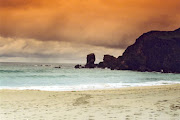In the late 18th century,the population of Dalmore was small,and mainly confined to the land by the shore("The Old Houses").From around 1800 there was a marked increase in the village's population,mainly,I think,with people moving in from neighbouring villages.Information of names and numbers are not easily available for these times,and any thing that is recorded in documents(eg The Seaforth Muniments)gives an overall picture rather than details of the poor souls whose presence there was precarious at best.The Seaforth Rentals only record the tacksmen renting ground from the Seaforth Estates - the farmer class and whose subtenants were the poor families who had to find means of paying rent to the tacksman.From the Seaforth Rentals of 1766,we see that Murdoch Macdonald(Murchadh Ban) is named as "tenant of Dalbeg" in 1780 and "tenant of Dalbeg and Dalmore" in 1787.
Stock lists: Compiled from time to time for the Seaforth Estates.An example is:
1824 Stock List for Dalmore. There is a list of 11 subtenants holding stock.There are 4 Macdonalds(Norman,Angus,John,Murdo),2 Morrisons(Murdo,Angus),4 Macleods(including Angus,a pensioner and Donald the piper)and lastly one Maclean.I wonder if the old Macleod bodach "could live off his pension" in 1824.
Militia Lists: The 1757 Militia Act was passed, so that in the event of war with another country, local militias would serve in defence of hearth and home,with the army proper fighting abroad.Eligible men(age,fitness,size of family)in each parish were balloted,and the men chosen appeared on the militia lists.They were the R.N.R or T.A of their day!
Appearing on Militia Lists for Dalmore were:
1825: 10 men(incl.4 Macdonalds)and 1 Morrison(Malcolm)
1827: 10 men(incl.5 Macdonalds) and 1 Morrison(Malcolm)
1831: Donald Morrison,Donald Macleod,Malcolm Macphail.
The first all-British census took place in 1841.and reveals that in that year 1841 Dalmore had a population of 87 persons which would make Dalmore a fairly populated glen.The favoured spots to inhabit were near the sandy beaches and machair where windblow has provided a natural blend of peat annd sand.The ruins of these peoples' homes can still be seen on the lands occupied by the present crofts 1,2 and 3.The large area of lazy-bed cultivation on Croft No.1.can best be appreciated on top of the adjacent beinn at sunset.Croft No.2.has as many as four ruined houses.Part of Dalmore lies to the south of the village in a parallel glen,and very fertile.This area is known locally as the Gearraidh,and is the coastal area between Geodha na Muilne and the wild sea inlet called Sielligach(sp?).This area has a large number of lazybeds,many ruins(not all of them houses)and two Norse style mills on the same river(Allt na Muilne).We will revisit the Gearraidh at a later date.
Dalmore Daytime

Sandy Beach
Tuesday, 22 January 2008
Subscribe to:
Post Comments (Atom)


No comments:
Post a Comment